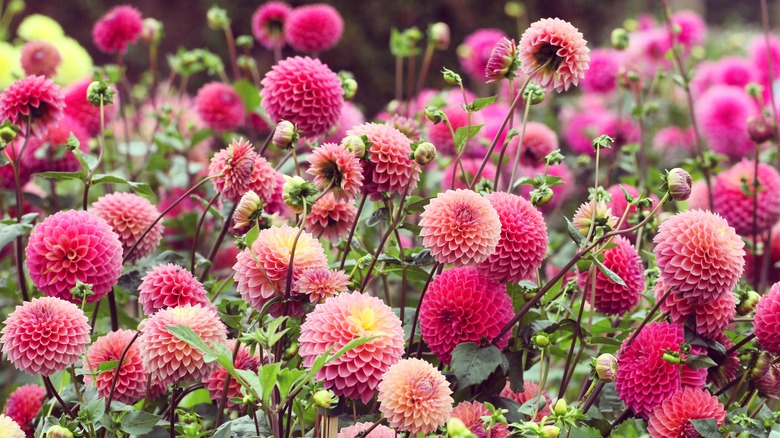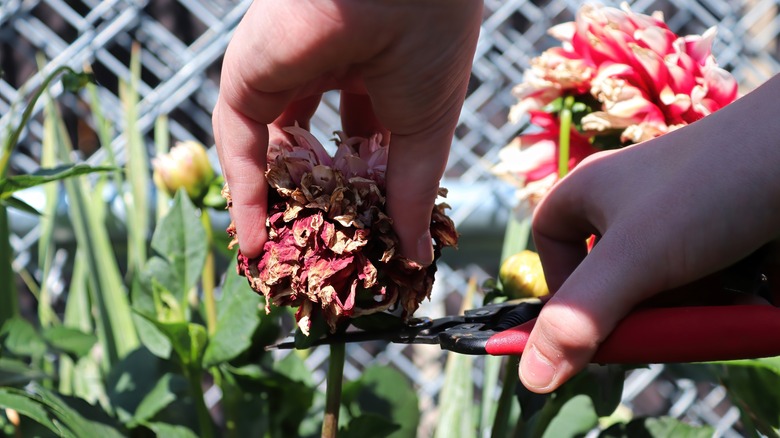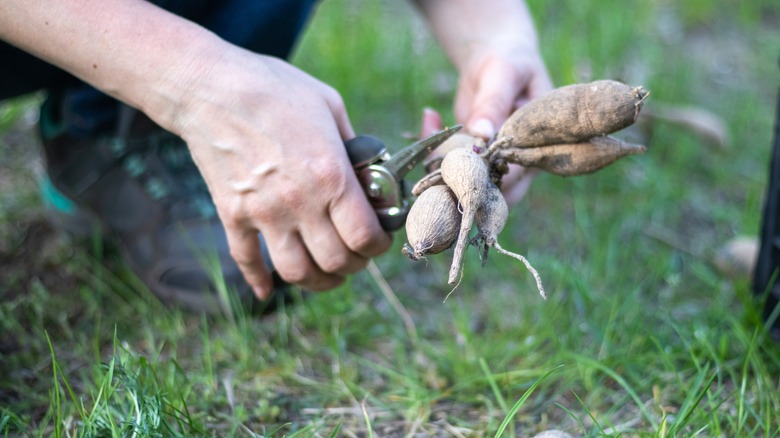Should I Mulch Over The Dahlia Tubers In My Garden? Advice From House Digest's Professional Gardener
Dahlias are a late summer delight. Their abundant petals, long blooming season, brilliant colors, and sturdy stems make them excellent cut flowers, and they bring seasonal beauty to any garden. These flowers are well-suited to warmer growing zones (like USDA 8-10) and are grown as annuals in warmer locations. In colder regions, they're known as "tender perennials," which means they need special care over the winter months. Mulching dahlias has different implications depending on whether you're talking about mulching them during the growing season or the dormant season. But it turns out that mulching over dahlias is not advisable for a number of reasons.
Mulching during the growing season can slow down a dahlia's growth, and doing so over the winter may cause tubers to rot. These vigorous bloomers are nevertheless somewhat temperamental when it comes to attempts to perennialize them, so it's best to nurture them to encourage their survival. That means avoiding mulch, which can lead to rot problems, except at a very narrow window of the season: midsummer.
In midsummer (mid-June through mid-August), once the plants are established and the flower buds have formed, a light layer of natural mulch to help prevent weeds and preserve moisture is fine. Lightweight mulch such as shredded pine bark or cocoa hulls (if you don't have dogs) works fine for dahlias. Again, in general, mulching over dahlias in spring or fall is not recommended, for reasons given below in more detail.
Caring for dahlias after spring planting
In spring, dahlia tubers should be planted after the soil has warmed up. They shouldn't be planted in wet soil, and you should avoid watering them for the first week or so. Too much cold or dampness, as well as lack of warmth, can cause dahlia tubers to rot, so mulch should not be used at this time. Also, mulching over newly planted dahlia tubers can slow down the plant's efforts to put out new growth. Place them in a sunny spot, planted between 6 and 8 inches deep, in well-draining soil.
There are other tips for keeping dahlias looking their best, such as pinching them back at the beginning of the season and deadheading the spent blooms later in the season. Again, it's best to avoid mulching the area until the middle of summer, after you've stopped pinching them back, to encourage growth. Then, use only a light layer of mulch if desired, as described above.
As the flowers appear in summer, they'll start to bloom in abundance. You should have plenty to cut for the vase as well as many in the garden, depending on how many plants you have. Some taller varieties may need staking, as the weight of the blooms can cause the stems to fall over.
Can I mulch over dahlias for the winter?
Dahlias bloom well into autumn, but once the first hard frost arrives, the leaves and petals start to blacken. This is the sign to prepare the tubers for the coming winter. Some gardeners in warm climates keep dahlias in the ground all year. However, in areas with cold, wet winters, leaving your dahlia tubers buried and mulching them can cause them to rot. If you want to grow your dahlias as "tender perennials," you must protect them from winter cold.
Even in a dry winter season, if dahlia tubers freeze, they may start to rot once the spring thaw occurs. In England, a location known for generally mild winter temperatures, the common wisdom is that dahlias should be lifted and stored for winter. Most gardeners who live in colder climates in the U.S. also dig up their dahlia tubers and store them over the winter to replant in spring. After digging them up, trim away any damaged parts, rinse off the soil, then let them dry thoroughly in the sun. Store in paper bags with some peat moss or sand.
If you live in Zone 7 or above, mulching your dahlia tubers heavily over the winter should provide them with sufficient protection from cold and moisture. Allow the planting area to dry out on a sunny day before adding the layer of winter mulch. Use at least 3 inches of mulch to protect them from cold and dampness until spring.


